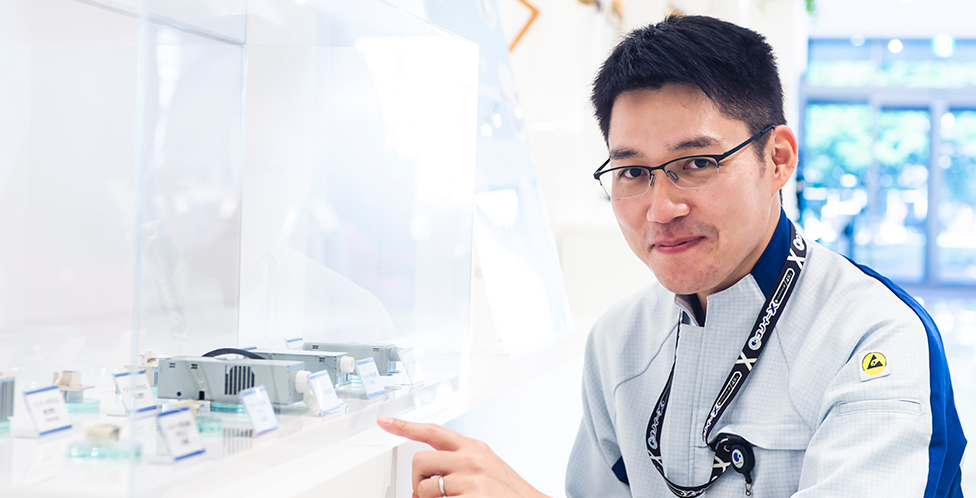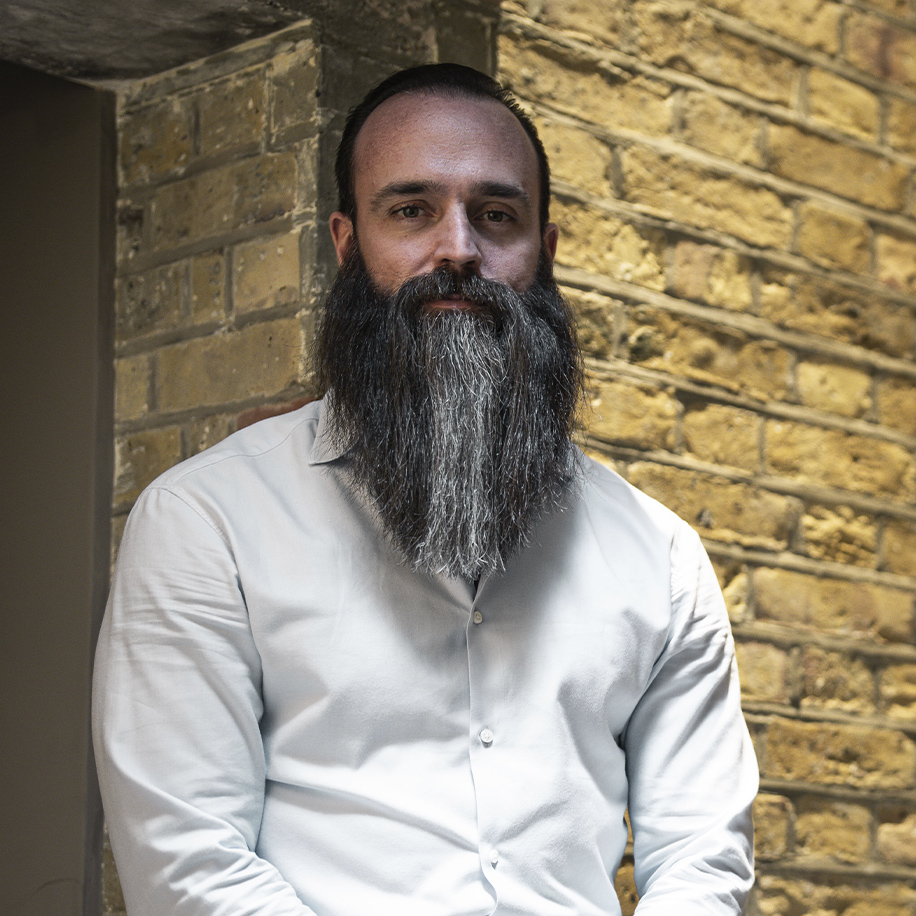The collaborations driving
the growing global appeal
of nanoe™ X

The ubiquity of nanoe™ X in Japan—incorporated
everywhere from homes to trains to hospitals—is helping
the technology gain traction overseas.
Text by Mari Maeda
Photography by Kunihisa Kobayashi

Have you heard of nanoe™ X, the Panasonic technology that produces ionized water particles that can purify and deodorize the air, disinfect surfaces, and cleanse the skin? The technology can be found in household appliances such as air conditioners and purifiers, washing machines, refrigerators, and beauty devices, as well as the infrastructure that supports our lives—our railways, hospitals, cars, and commercial facilities. We may not be aware of this technology, but it is always around us, ensuring we can live in comfort.
This technology is developed at a Panasonic plant in Hikone, Shiga Prefecture. It is here that Akihito Hirohata, formerly a product manager for nanoe™ in Europe, works as a staff engineer. From 2016 to 2021, Hirohata was responsible for expanding sales of the technology from his offices in Munich. When the new nanoe™ X was released, he was involved in its promotion from the very beginning. He played a key role in securing a deal with UK-based automaker Jaguar Land Rover that installed nanoe™ X devices in the company’s latest models.
“I was very proud of securing that deal,” says Hirohata. “But what was more important to me was that JLR genuinely valued the cutting-edge nature of nanoe™ X technology and continues to actively promote its effectiveness in the media and on its own website.”
We sat down with Hirohata to talk about the businesses in Japan and Europe that have been won over by nanoe™ X, as well as the future of this technology—how it may transform over time and which untapped markets offer potential applications.
A Boost from a Major Carmaker
How do you feel Europeans view nanoe™ X?
I’m glad to say that there were many businesses that have shown interest in nanoe™. There are very few other companies in the world that are developing similar technology, and we had a key advantage: nanoe™ has been incorporated not just in our own products, but also by Toyota and other Japanese automakers, as well as many railway companies and hospitals in Japan.
Among our customers, JLR was one of the earliest proponents of good air quality as a key element in providing a luxury onboard environment. The fact that they rated nanoe™ so highly made us much more confident about expanding our market to the rest of the world…they were definitely interested in its ability to disinfect and render hazardous substances harmless—even more so after the outbreak of COVID-19.
What was the deciding factor for JLR?
The deciding factor was a live demonstration in an actual car. When some JLR executives decided to visit Japan, we invited them to observe a deodorization experiment we were conducting at Panasonic Center Tokyo so they could witness the effects of nanoe™ X firsthand. The X version can deodorize much faster than the original nanoe™, and when the executives saw this, they were so impressed that they immediately began discussing a deal.
JLR has long been a customer of Panasonic, and they’ve been telling us recently that they’d like to more actively promote the ability of their cars’ air conditioning system to incapacitate viruses and bacteria. They’ll ask us how to convey the actual effects of the technology, as well as whether they can publish our inhouse data in press releases. I get the strong sense that JLR really wants to show the world how safe and sound their cars are thanks to nanoe™.
In which models has the technology been incorporated?
Currently, you can find nanoe™ in recent launches such as the new Range Rover and Range Rover Sport as well as the Velar, Evoque, Defender and Discovery. Once we had successfully built nanoe™ devices into the JLR models, it was relatively easy to do so for Jaguar models, and now, nanoe™ is also incorporated into the I-PACE, F-PACE, and XF.
Not Just as a Supplier
So you’re not just a supplier. You’re also involved in designing the systems that incorporate the technology.
Yes. No matter what product or system is involved, we generally avoid simply handing over the device and calling it a day. Our approach is to work on the design together with our customer and tailor it to the environment in which the technology will be used, so that our customer gets the most out of the technology.
It’s only natural for our customers not to know how to incorporate a technology they’re using for the first time, and there’s only a limited amount of space in a product or system to accommodate a new part. This is why we send in a specialist to supervise the design process from beginning to end; they can adjust the layout to meet our customer’s needs, but in a way that does not impact the technology’s effectiveness. We’ve taken the same approach with train air conditioning systems, as well as our own air-e ceiling nanoe™ devices.
Trains, Hospitals, and Hotels
Tell us about some of your other customers.
There are numerous Japanese carmakers, including Lexus, Toyota, and numerous railway lines such as the operators of the Seven Stars in Kyushu luxury train. While a car is a private space, a train is an enclosed environment that at any given time could be carrying anywhere from a few people to a large crowd—I think that’s why people worry more about the air on a train. It’s also easy to come into physical contact with other passengers, which is why railway lines are so keen on nanoe™—it’s effective at removing viruses on surfaces, not just in the air. These are the reasons why nanoe™ would also be effective in elevators.
Hospitals, dental clinics, and other medical institutions that have high cleanliness requirements have also incorporated nanoe™ devices. Some of these places openly advertise their use of the technology to promote their high hygiene standards. And in time for the Tokyo Olympics, Toyota incorporated nanoe™ X devices in its JPN TAXI cabs to provide passengers with both a clean space and peace of mind.
An increasing number of hotels have installed our air-e devices and air purifiers. Although we are slowly adjusting to life with COVID-19, many people are still hesitant about staying in a room where someone else has been. With nanoe™, hotels can keep their rooms clean and disinfected at all times. Luxury hotels in particular attract a clientele that tends to be more informed about health and safety issues, and I think indoor air quality will become an important factor for attracting them. I believe more and more industries will find a need for this technology.
What would you say is the most important quality of nanoe™?
Much of the air conditioning technologies developed by other companies involve collecting stale air and replacing it with clean air. With nanoe™, we disperse particles into the air that help render hazardous substances harmless. It’s this novel approach that I think sets nanoe™ apart from its competition. When Panasonic began developing nanoe™ twenty years ago, it was because they concluded that simply replacing the air was not enough to keep a space clean. You need to be able to act against viruses and bacteria not just in the air, but also on the floors, sofas, clothes, and other surfaces. This is what nanoe™ does, and in that sense it’s entirely unique.
Growing Faster and More Powerful
The rate of ionized water particles produced by nanoe™ X technology has grown exponentially over a very short period of time. Will this trend continue?
The first nanoe™ was capable of producing 480 billion particles per second. Since the release of nanoe™ X, the rate has increased to 4.8 trillion, 9.6 trillion, and now 48 trillion per second. In other words, the rate has grown by tenfold, twentyfold, and hundredfold in a very brief period. The greater the rate, the quicker the particles can do their job—something people attending our deodorization demonstrations realize immediately. We definitely want to see how much more we can increase this rate and work with our customers to figure out more effective ways to deploy these particles. This in turn could drive innovation in our nanoe™ X devices.
What is the future of nanoe™?
We’re in the middle of an unprecedented pandemic, so I do hope that the use of nanoe™ continues to spread throughout the world. We are dealing with a threat we can’t see, and I want this technology to reassure the public about the air’s safety—something it can do if we increase the rate of particles produced and raise the technology’s performance. It helps that the technology’s effectiveness has been evaluated all across the world—we can promote these results to further deepen the public’s trust in this technology and help them better understand what exactly nanoe™ does.
The current nanoe™ X capable of producing 48 trillion particles per second is available only in Japan for now; we are just getting started on promoting it overseas. The difference between this technology and the previous version is noticeable; for example, it takes only a fraction of the time to deodorize a space. I think these kinds of results give us a chance to get through to businesses that may not have been interested in this technology in the past. We’ve also developed devices for commercial use that incorporate the current nanoe™ X, which I’m hoping will help us rapidly expand the market for this technology.
Profile
Akihito Hirohata, Panasonic Staff Engineer
After getting his Master’s in mechanical engineering, Hirohata joined Panasonic in 2011. He has since worked at a Panasonic plant in Hikone, Shiga Prefecture, that serves as the main factory for nanoe™ technologies. From 2016 to 2021, he was stationed in Munich, where he served as product manager for nanoe™ devices and marketed the products to European businesses. Following his return to Japan, Hirohata has been busy designing frameworks for collecting evidence on the safety benefits provided by nanoe™ technologies and promoting these results, primarily in Europe and North America. He sees such efforts as key to accelerating the global expansion of the nanoe™ market.
Click here to contact us about products with nanoe™ X technology



















